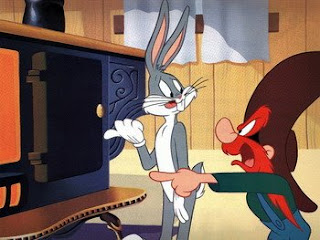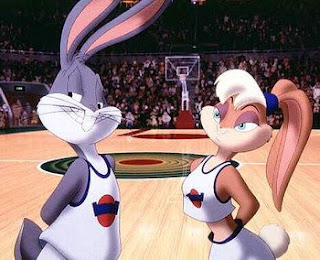 label : Bugs Bunny, Bugs Bunny cartoon character, Bugs Bunny funy pictures.
label : Bugs Bunny, Bugs Bunny cartoon character, Bugs Bunny funy pictures. Bugs Bunny's origin was as a goofy antagonist for Porky Pig in the Warner Bros. cartoon Porky's Hare Hunt (1938), directed by Cal Dalton and Ben "Bugs" Hardaway, for whom the hare is named. Plotwise, it was virtually a repeat of the previous year's Daffy Duck intro, Porky's Duck Hunt, Back then, (our) Bugs was much smaller and more rabbit-like, and completely white but in wit, resourcefulness, and the sheer relish with which he demolished his antagonist, he very much resembled his later self.
Bugs evolved in a generally Bugs-like direction for a couple of years, emerging fully-developed in the Oscar-nominated A Wild Hare (1940), directed by Tex Avery. It was there that he first munched a carrot, first uttered his trademark line, "Eh, what's up, Doc?", and first kissed Elmer Fudd. The only thing missing was his name. He'd been referred to as "Bugs's Bunny" from the beginning, but it was only in Elmer's Pet Rabbit (1941), directed by Chuck Jones, that he was first called "Bugs Bunny" on-screen.
 Bugs also received an Oscar nomination for Hiawatha's Rabbit Hunt (1942), and won the award for Knighty-Knight Bugs (1958). Both were directed by Friz Freleng. Other well-remembered Bugs cartoons include Tortoise Beats Hare (1941), by Avery, which re-enacts the old story; The Old Grey Hare (1944), directed by Robert Clampett, in which Bugs, known for sometimes-spectacular death scenes, tops himself by digging his own grave; Hillbilly Hare (1950), directed by Robert McKimson, which contains the tour-de-force "square dance scene", one of the greatest sustained gags in animation history; and What's Opera, Doc? (1957), by Jones, which crams Wagner's entire Ring Cycle into a seven minute cartoon.
Bugs also received an Oscar nomination for Hiawatha's Rabbit Hunt (1942), and won the award for Knighty-Knight Bugs (1958). Both were directed by Friz Freleng. Other well-remembered Bugs cartoons include Tortoise Beats Hare (1941), by Avery, which re-enacts the old story; The Old Grey Hare (1944), directed by Robert Clampett, in which Bugs, known for sometimes-spectacular death scenes, tops himself by digging his own grave; Hillbilly Hare (1950), directed by Robert McKimson, which contains the tour-de-force "square dance scene", one of the greatest sustained gags in animation history; and What's Opera, Doc? (1957), by Jones, which crams Wagner's entire Ring Cycle into a seven minute cartoon. The last theatrically-released Bugs Bunny cartoon was False Hare (1964), by McKimson. But The Bunny never faded away. He continued to appear on television, not just in packages of cartoons sold to local TV stations and on his network Saturday morning show, but also in commercials advertising a variety of products.
During the 1970s and '80s, he appeared in a long succession of prime-time TV specials and even feature films, produced by his old directors, and consisting mainly of clips from the old cartoons. In 1996, he and his Looney Tunes cohorts were catapulted back into the limelight when they co-starred with Michael Jordan in the feature film Space Jam. Two years later, he appeared on a U.S. postage stamp.
 In comics, Bugs did not fare so well. He appeared in both newspaper strips and comic books between the 1940s and the '70s, but none of them truly captured his character; nor were any notable writers or artists associated with him. In recent years, he has been revived as a comic book character, appearing regularly in the monthly Looney Tunes Comics, an occasional oneshot or mini-series of his own, and even as a co-star with Superman.
In comics, Bugs did not fare so well. He appeared in both newspaper strips and comic books between the 1940s and the '70s, but none of them truly captured his character; nor were any notable writers or artists associated with him. In recent years, he has been revived as a comic book character, appearing regularly in the monthly Looney Tunes Comics, an occasional oneshot or mini-series of his own, and even as a co-star with Superman. Today, the original Bugs Bunny cartoons can still be seen regularly on television, alongside telephone commercials spun off from Space Jam. The Bunny shows no sign of ever giving up his stardom.
from : geocities.com/tazluvruk3
